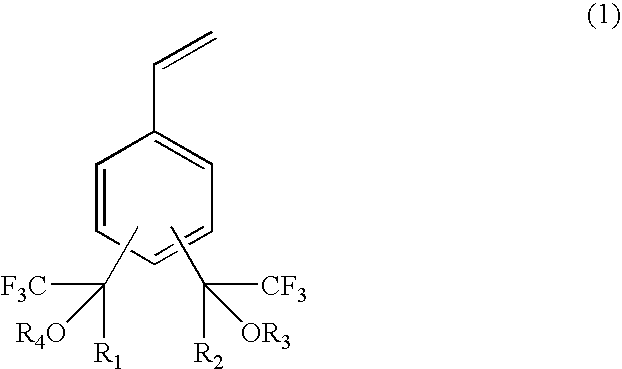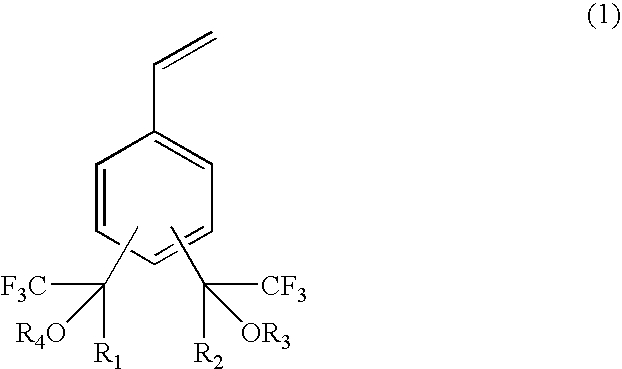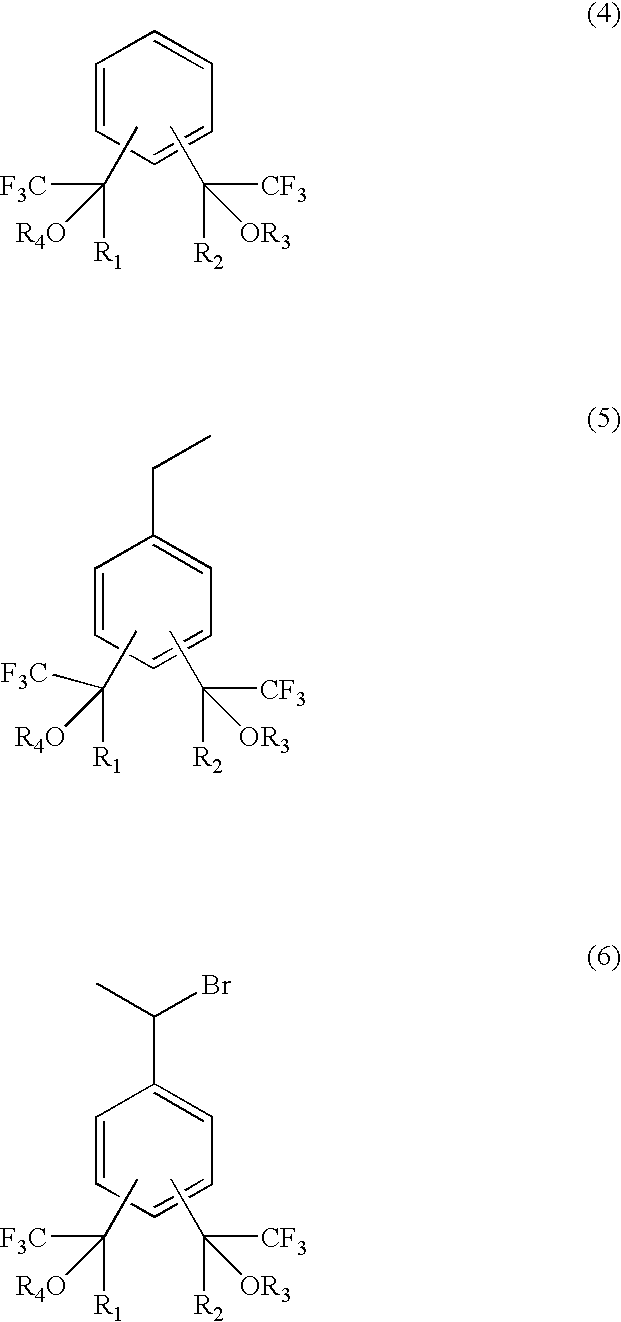Fluorine-containing polymerizable monomers and polymers, anti-reflection film materials and resist compositions using same
a technology of anti-reflection film and fluorine, which is applied in the direction of photosensitive materials, bulk chemical production, instruments, etc., can solve the problems of few proposals for improving water repellency and adhesion, and achieve the effects of improving adhesion to the substrate, low refractive index, and high transparency
- Summary
- Abstract
- Description
- Claims
- Application Information
AI Technical Summary
Benefits of technology
Problems solved by technology
Method used
Image
Examples
example 1
Production of Styrene Derivative (3,5-D-HFA-ST) Represented by the Formula (3)
[0136]A styrene derivative (hereinafter 3,5-D-HFA-ST) represented by the formula (3) was synthesized by the following steps (a), (b) and (c).
[0137]
[0138]Step (a): Ethylation of Benzene Derivative
[0139]A three necked flask equipped with a reflux condenser, a dropping funnel and a stirrer was charged with 100 g of a benzene derivative (hereinafter 1,3-Bis-HFAB) represented by the formula (15) and 83 g of anhydrous aluminum chloride, followed by heating in oil bath of 50° C. 133 g of ethyl bromide were added in a dropwise manner from the dropping funnel by spending 5 hr. After the reaction, the reaction solution was added to 500 ml of iced water. A black-color oil-like substance precipitated in the lower layer was taken out and then washed with water. This product was subjected to a distillation under vacuum, thereby obtaining 30 g of an ethyl benzene derivative represented by the formula (16). This benzene d...
example 2
Homopolymerization of 3,5-D-HFA-ST
[0147]A three-necked flask equipped with a reflux condenser and a stirrer was charged with 10 g of 3,5-D-HFA-ST (see the formula below), 0.2 g of AIBN (a polymerization initiator), and 40 g of n-butyl acetate (a polymerization solvent), followed by heating in oil bath of 60° C.
[0148]
Under this condition, the reaction was conducted for 20 hr. After that, 1 liter of n-hexane was added to the reaction solution, followed by stirring. The resulting precipitate was separated by filtration and then dried under vacuum at 50° C. for 18 hr. The obtained polymer composition was determined by 1H-NMR and 19F-NMR. Its weight average molecular weight (Mw) and number average molecular weight (Mn) were determined by gel permeation chromatography (GPC) using polystyrene as a standard. The results are shown in Table.
[0149]
TABLEPolymerCompositionYield(3,5-D-HFA-ST / Ex.Charged Monomers (g)(g)Comonomer(s))MnMwMw / Mn23,5-D-HFA-ST(10 g) / -4.8100 / 0 8,00013,6001.733,5-D-HFA-ST(...
example 3
Copolymerization of 3,5-D-HFA-ST & 3,5-D-HFA-ST-BOC
[0150]Example 2 was repeated except in that 10 g of 3,5-D-HFA-ST and 8.0 g of 3,5-D-HFA-ST-BOC (represented by the following formulas) were used as the monomers in place of 10 g of 3,5-D-HFA-ST. The results are shown in Table.
[0151]
PUM
| Property | Measurement | Unit |
|---|---|---|
| Structure | aaaaa | aaaaa |
| Polydispersity index | aaaaa | aaaaa |
Abstract
Description
Claims
Application Information
 Login to View More
Login to View More - R&D
- Intellectual Property
- Life Sciences
- Materials
- Tech Scout
- Unparalleled Data Quality
- Higher Quality Content
- 60% Fewer Hallucinations
Browse by: Latest US Patents, China's latest patents, Technical Efficacy Thesaurus, Application Domain, Technology Topic, Popular Technical Reports.
© 2025 PatSnap. All rights reserved.Legal|Privacy policy|Modern Slavery Act Transparency Statement|Sitemap|About US| Contact US: help@patsnap.com



